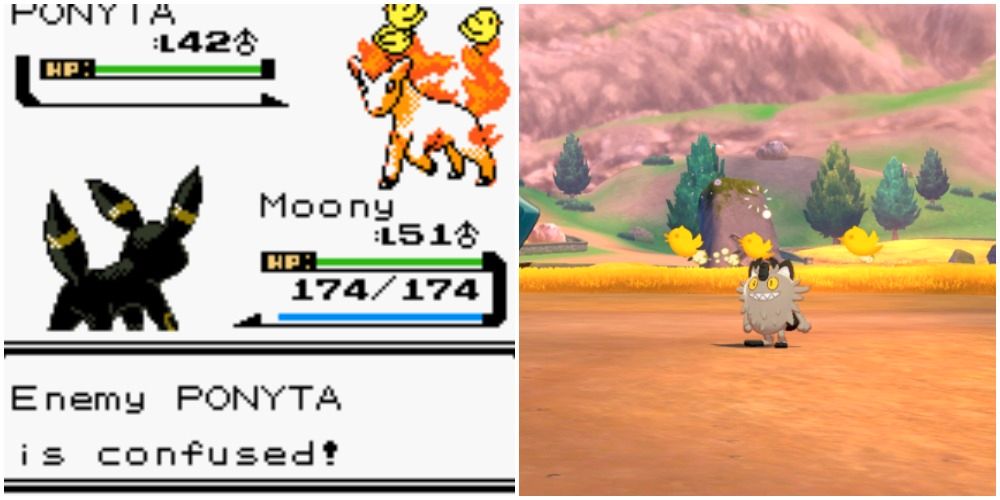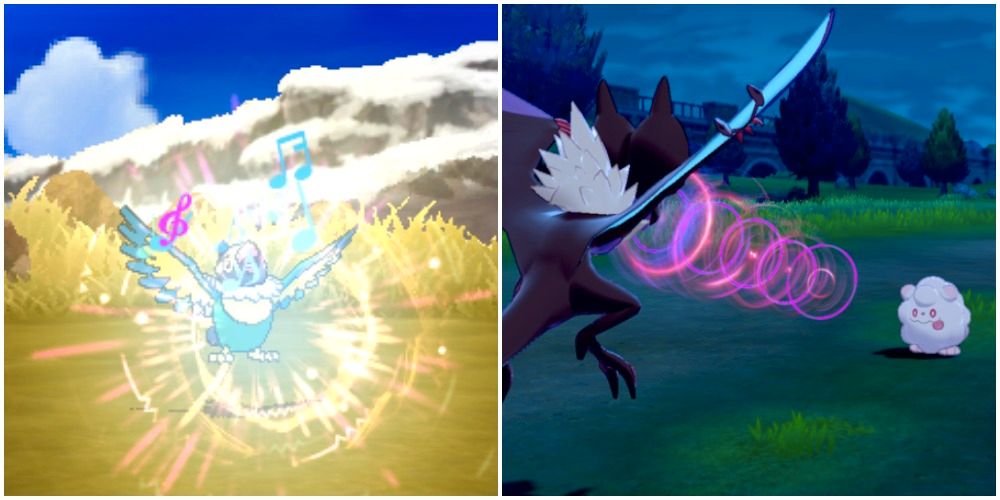Quick Links
- Confusion Throughout The Generations Of Main Series Pokemon Games
- Moves That Can Cause Confusion In The Main Series Pokemon Games
When it comes to the main status conditions in Pokemon Sword & Shield, only one can be inflicted on a target at a time, however, there are minor status conditions that can work in conjunction with the major ones. Confusion is such a minor status condition, however, it can arguably be more devastating to foes than any of the major ones, even by itself.
RELATED: Pokemon: Everything You Need To Know About One-Hit KO Moves
Being confused will cause an afflicted pokemon to potentially hit themselves instead of using their desired move. Both preventing the foe from attacking or buffing while also causing them to take damage is a powerful combination of effects, however, Confusion doesn't last very long, so it cannot often be relied upon by itself to win battles.
Confusion has changed a bit over the years, with its usage in Pokemon Sword & Shield being the result of years of refining. To make the most of this status condition on a confounding build, be sure to take note of the intricacies of Confusion.
Confusion Throughout The Generations Of Main Series Pokemon Games

Confusion In Generation 1 Pokemon Games
Immediately different from any other status condition, Confusion's damage (if an afflicted pokemon hits themselves) is calculated as if it was a typeless physical damage-dealing move with a base power of 40. This means that pokemon with higher Attack stats will always do more damage to themselves if affected by Confusion's effects.
When a pokemon is confused, it will have a 50% chance to hit itself for a duration between 2 to 5 turns. However, on the last turn of effectiveness, the effect will wear off before the afflicted pokemon can use its move and potentially hurt itself.
Confusion In Generation 2 Pokemon Games
For the most part, the mechanics behind Confusion have not changed a great deal since Generation 1, again unlike many other status conditions. However, there have been updates to how Confusion works alongside certain held items.
In Generation 2, Focus Band was introduced as an item that has a low chance to prevent pokemon from being knocked out by move-based damage. However, even though the damage caused by Confusion is the result of a damage calculation just like an incoming attacking move from an enemy, it does not trigger the effect of Focus Band.
Confusion In Generation 3 Pokemon Games
As the franchise's games became more complex and more capable of holding new mechanics, the developers made it so that Focus Band now can be activated by the self-damage dealt from Confusion's effect.
RELATED: Pokemon: How Damage Is Calculated
Confusion In Generation 4 Pokemon Games
Focus Sash, an item very similar to Focus Band, was added to the game. Like Focus Band, it can be triggered by the self-damage of Confusion's effect. Though, since Focus Sash only activates when the holder has full HP when hit, it doesn't matter quite as much due to it being very unlikely that an afflicted pokemon will be able to one-shot itself with the 40 base power Confusion self-damage.
Confusion In Generation 5 Pokemon Games
Despite being around since Generation 3 and having virtually the same effect as Focus Band and Focus Sash, the ability Sturdy was not able to be triggered by the self-damage of Confusion's effect. This was changed in Generation 5 to work identically to Focus Sash when it comes to being triggered by Confusion-related damage.
Confusion In Generation 6 Pokemon Games
There were no changes made to Confusion or related mechanics in Generation 6 Pokemon games.
Confusion In Generation 7 Pokemon Games
Confusion now only has a 33% chance to cause an afflicted pokemon to hit itself in the greatest nerf this status condition has ever seen in the franchise.
Confusion In Generation 8 Pokemon Games
After the nerf in Generation 7, there have been no changes to how Confusion works in the main series Pokemon games.
Moves That Can Cause Confusion In The Main Series Pokemon Games

| Move Name | Probability Of Causing Confusion | Description |
| Chatter | 100% | Between Generation 4 to Generation 6, the chance of causing Confusion depended on the volume of a manually-created recording for this move made by the player |
| Confuse Ray | 100% | A regular status move |
| Dynamic Punch | 100% | A damage-dealing physical move |
| Flatter | 100% | Raises the target's Special Attack stat (by 1 stage) |
| G-Max Gold Rush | 100% | Scatters money on the ground that is picked up after the battle and is the exclusive G-Max move of Gigantamax Meowth |
| G-Max Smite | 100% | Targets all opponents and is the exclusive G-Max move of Gigantamax Hatterene |
| Supersonic | 100% | A regular status move |
| Swagger | 100% | Raises the target's Attack stat (by 2 stages) |
| Sweet Kiss | 100% | A regular status move |
| Teeter Dance | 100% | Targets all pokemon except self (including allies) |
| Hurricane | 30% | A damage-dealing special move |
| Secret Power | 30% | Can only potentially cause Confusion while on Rocky Terrain (only possible in Generation 3 games) |
| Dizzy Punch | 20% | A damage-dealing physical move |
| Rock Climb | 20% | A damage-dealing physical move |
| Strange Steam | 20% | A damage-dealing special move |
| Water Pulse | 20% | A damage-dealing special move |
| Confusion | 10% | A damage-dealing special move |
| Psybeam | 10% | A damage-dealing special move |
| Signal Beam | 10% | A damage-dealing special move |
MORE: Pokemon: Everything You Need To Know About Move Priority

